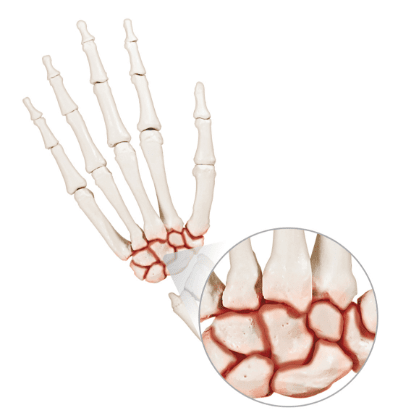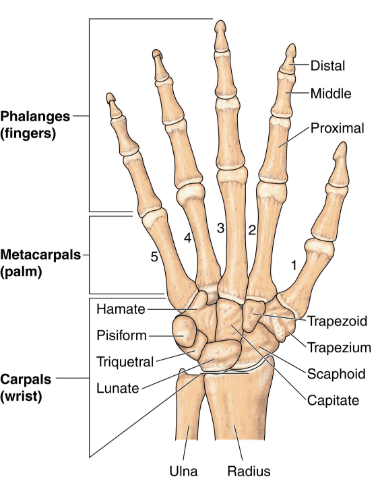Why does my wrist hurt?
To get a better idea of why your wrist hurts, take a look at how it works. Your wrist moves in many ways and helps provide the hand with very finely detailed movements: it flexes and extends, it turns out and turns in, and even moves in a circle. When they’re working well, you don’t think about the eight carpal bones of your upper hand, the two bones of your forearm, or all the soft tissue helping them work well together at the wrist. But, when something’s wrong, the pain can be debilitating.


The wrist and hand bones fit together like no other joint. A complex of bones and joints, the wrist bridges the two rows of small carpal bones of the hand to the two forearm bones.
Many working parts
Because the wrist involves so many parts, even a small injury can begin to create bigger problems. Your pain may be due to overuse, an injury, or chronic swelling or inflammation – most often referred to as arthritis.
osteoarthritis (OA) a common form of arthritis associated with wrist pain, can be caused by wear-andtear over time or can develop years after an injury.
Post-traumatic arthritis develops when bone and cartilage don’t heal properly after an injury. When an injury doesn’t heal smoothly, resulting scar tissue can get in the way and cause pain.
Rheumatoid arthritis leaves the door open for unwelcome changes in the bone as the soft tissue that stabilizes and lubricates the joint becomes inflamed and painful.
Carpal tunnel syndrome is a painful condition often felt in the palm of the hand at the base of the thumb, index finger, middle finger, and thumb-side of the ring finger. When the median nerve that travels through the complex wrist joint becomes compressed by the tissue surrounding it (the carpal tunnel), you may experience pain, numbness, tingling, and even grip weakness.
Your doctor will examine your wrist and may ask you to take a few tests to determine the cause of your pain.
What will a doctor do?
At your first appointment, your orthopaedic doctor will assess what’s going on. You’ll answer a few questions about when and where your wrist hurts. The doctor may understand what’s going on right away because you show classic symptoms of a particular problem. The doctor may also ask you to have an additional diagnostic test, like an X-ray or an MRI.
Pain relief doesn’t always mean surgery. Your doctor may recommend a combination of treatments to alleviate your pain – perhaps a course of physical therapy, rest, ice, or over-the-counter anti-inflammatory medication. If you have severe pain, swelling, or discoloration, seek emergency medical treatment.
One out of every four Americans has some form of arthritis.1
References:
- The Center for Disease Control and Prevention. Arthritis. https://www.cdc.gov/chronicdisease/resources/publications/factsheets/arthritis.htm
VariAx 2 Wrist Fusion System
Indications: The Stryker VariAx 2 Wrist Fusion System is indicated for wrist arthrodesis and fixation of fractures in patients with wrist arthritis or fractures of other small bones of the carpus. Specific indications include: Post-traumatic arthritis of the joints of the wrist, Rheumatoid wrist deformities requiring restoration, Complex carpal instability, Post-septic arthritis of the wrist, Severe unremitting wrist pain related to motion, Brachial plexus nerve palsies, Tumor resection, Spastic deformities, Contra-Indications: The physician’s education, training and professional judgment must be relied upon to choose the most appropriate device and treatment.
For all warnings and precautions please refer to the appropriate labeling.
Conditions presenting an increased risk of failure include: Any active or suspected latent infection or marked local inflammation in or about the affected area, Compromised vascularity that would inhibit adequate blood supply to the fracture or the operative site, Bone stock compromised by disease, infection or prior implantation that can not provide adequate support and/or fixation of the devices, Material sensitivity, documented or suspected, Obesity. An overweight or obese patient can produce loads on the implant that can lead to failure of the fixation of the device or to failure of the device itself, Patients having inadequate tissue coverage over the operative site, Implant utilization that would interfere with anatomical structures or physiological performance, Any mental or neuromuscular disorder which would create an unacceptable risk of fixation failure or complications in postoperative care, Other medical or surgical conditions which would preclude the potential benefit of surgery
Source: VAX-ST-23
ReMotion Total Wrist System
Indications: The ReMotion Total Wrist System is intended for replacement of the painful wrist joint due to rheumatoid arthritis, osteo-arthritis, or post-traumatic arthritis.
Contraindications: Bone, musculature, tendons, or adjacent soft tissue compromised by disease, infection, or prior implantation, which cannot provide adequate support or fixation for the prosthesis.
Known sensitivity to materials used in this device. Skeletal Immaturity
Source: V15114
The information presented is for educational purposes only. Stryker is not dispensing medical advice. Please speak to your doctor to decide which type of surgery is right for you. Only your doctor can make the medical judgment which products and treatments are right for your own individual condition. As with any surgery, joint replacement surgery carries certain risks. Your surgeon will explain all the possible complications of the surgery, as well as side effects. Additionally, the lifetime of a joint replacement product is not infinite and varies with each individual. Also, each patient will experience a different post-operative activity level, depending on their own individual clinical factors. Your doctor will help counsel you about how to best maintain your activities in order to potentially prolong the lifetime of the device.
Stryker Corporation or its divisions or other corporate affiliated entities own, use or have applied for the following trademarks or service marks: ReMotion, Stryker, T2, Together with our customers, we are driven to make healthcare better, VariAx. All other trademarks are trademarks of their respective owners or holders.
REM-AWI-1_Rev-1, 01-2019